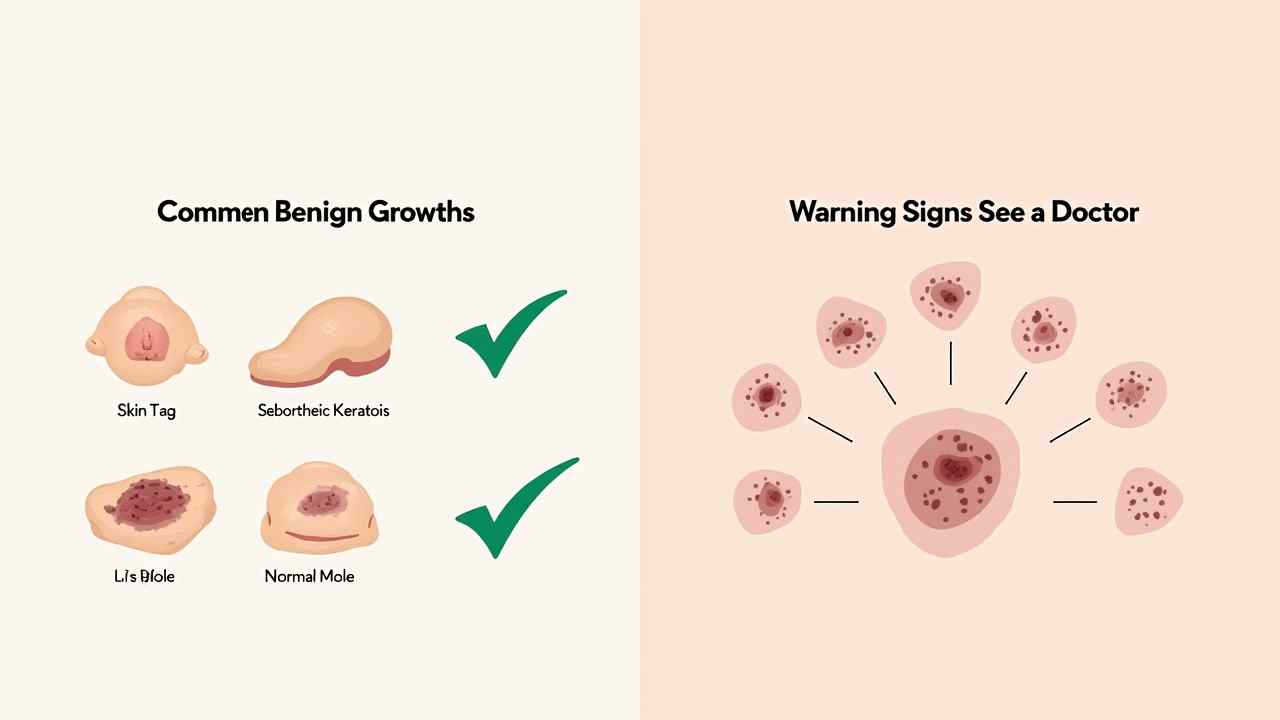
🩺 A Dermatologist's Guide to Common Skin Growths (When to Worry)
🩺 A Dermatologist's Guide to Common Skin Growths (Benign vs. Worrisome) 🩺
❗ CRITICAL MEDICAL WARNING: Any new, changing, or unusual skin growth must be evaluated by a board-certified dermatologist. Self-diagnosis is dangerous. Early detection of skin cancer is crucial. This guide is for general informational purposes only and is not a substitute for a professional medical examination.
Noticing a new spot or bump on your skin can be alarming. Your mind might immediately jump to the worst-case scenario. However, it is important to know that the vast majority of skin growths are completely harmless. Your skin is a dynamic organ, and changes are a normal part of life.
This guide will help you understand the difference. We will explain the most common types of benign (non-cancerous) growths. Most importantly, we will show you the warning signs that mean you need to see a doctor. Let's get to know your skin better. ✅
🤔 What Are the Most Common Benign Skin Growths?
Most of the spots and bumps that appear on our skin are benign. They are not cancerous and pose no threat to your health. They are often just cosmetic concerns. Here are some of the most common ones.
What is a Skin Tag?
Skin tags are small, soft, flesh-colored growths. They often hang off the skin. They are extremely common. They usually appear in areas of friction, like the neck, armpits, and groin. They are completely harmless.
What is a Mole (Nevus)?
A mole is a very common type of skin growth. It is a cluster of pigmented cells. Most people have them, and most are benign. A normal mole is usually an evenly colored brown or tan spot. It can be flat or raised. It can be round or oval with a smooth border.
What is a Seborrheic Keratosis?
These are very common, especially as we age. They often look like waxy, brown, black, or tan growths. They have a "stuck-on" appearance, like a dab of candle wax. They are not cancerous and are not a cause for concern.
What is a Cherry Angioma?
These are small, bright red bumps. They are made up of a cluster of tiny blood vessels. They are very common and completely harmless. They can appear anywhere on the body.
⚠️ When Should You Be Worried About a Skin Growth? (The ABCDEs of Melanoma)
This is the most important part of this guide. While most growths are benign, some can be a sign of skin cancer. You should perform a skin self-exam once a month. Look for any new or changing spots. The "ABCDE" rule is the best way to spot the warning signs of melanoma, the most serious type of skin cancer.
A is for Asymmetry: One half of the spot does not match the other half.
B is for Border: The edges are irregular, ragged, notched, or blurred.
C is for Color: The color is not uniform. It may have shades of brown, black, pink, red, white, or blue.
D is for Diameter: The spot is larger than 6 millimeters across (the size of a pencil eraser). However, melanomas can sometimes be smaller when first detected.
E is for Evolving: The mole is changing in size, shape, color, or is a new symptom like bleeding or itching.
Also, look for the "Ugly Duckling" sign. This is a mole that looks different from all the other moles on your body. If any skin growth fits these criteria, it is a sign to see a doctor immediately.
- What Should You Do if You Find a Suspicious Spot?
The only correct answer is to make an appointment with a board-certified dermatologist. They will examine the spot, often with a special magnifying tool called a dermatoscope. If they are concerned, they may perform a skin biopsy to get a definitive diagnosis.
Early detection is the key to successfully treating skin cancer. Even during the cooler autumn months here in Bursa, the sun is still strong enough to cause damage. Protect your skin and check it regularly. It is the most important thing you can do for your long-term health. 🩺